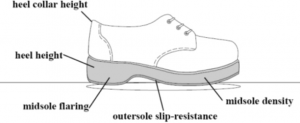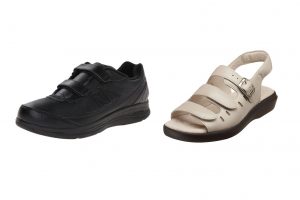Are Shoes to blame for Falls?
 Falls are the primary reason for admission to hospital in people aged 65 years and over. In fact, one in three older people over 65 in the community will have a fall this year.
Falls are the primary reason for admission to hospital in people aged 65 years and over. In fact, one in three older people over 65 in the community will have a fall this year.
A fall can have a huge impact on your ability to stay independent for longer, and can result in impaired mobility, disability, fear of falling, and reduced quality of life. Footwear is a significant risk factor in the prevalence of falls.
What makes a safe shoe?
A correctly fitting, supportive shoe can help reduce your risk of falling. A safe shoe has the following features:

Anatomy of a safe shoe
- A high, firm heel collar to give support when walking and provide stability
- Heel height should be less than 2.5cm
- Laces, buckles or Velcro fastening to ensure the shoe ‘holds’ onto your foot when walking. Avoid slip on shoes.
- A low, wide heel with a rounded edge togive more contact with the ground and help prevent slipping
- A wide and deep toe box allowing plenty of room for toes and comfort
- A thin, firm midsole with a tread so you can ‘feel the ground’ underneath and prevent slipping.
Shoe Shopping Tips

Suitable footwear examples
- Try both shoes on and buy for fit, not size
- Feet tend to swell during the day, so try shoes on mid-afternoon, with your usual socks or stockings and orthotics
- Make sure the sole is not slippery
- Walk around in the shop to ensure that the shoes fit properly and the heels don’t slip
- Ask your podiatrist about specialist shoe stores if you have trouble finding suitable shoes because of foot problems.
Older people who fall are more likely to fall again (Stubbs et al 2014), so it is recommended that you reduce all modifiable risk factors for falls and a great place to start is to choose the right shoes so you don’t go head over heels!
At ProMed, we are passionate about your foot health and preventing falls.
Call our friendly staff on 5522 1230 or book online.
